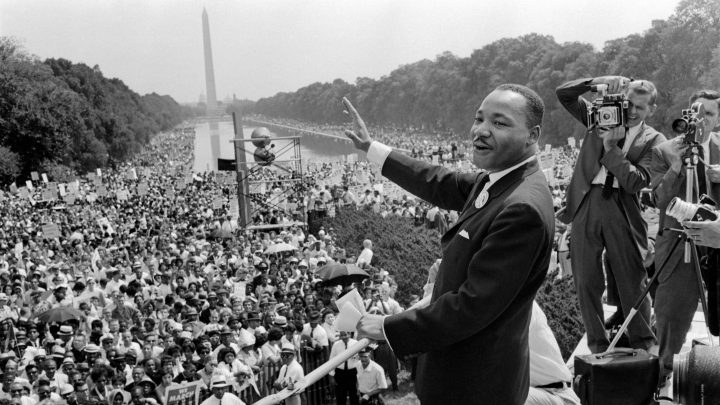
There’s more evidence that subsidized jobs boost racial equity, report finds
There’s more evidence that subsidized jobs boost racial equity, report finds

Later this month, we’ll celebrate the 60th anniversary of the March on Washington for Jobs and Freedom, where Dr. Martin Luther King Jr. delivered his “I Have a Dream” speech and called for a “massive federal program to train and place all employed workers — Negro and white — on meaningful and dignified jobs at decent wages.”
There is still a long way to go to achieve the social and economic dreams marked on that day. But in the last 50 years, subsidized employment programs have helped get and keep Black Americans in the labor force, improving their economic well-being, a Georgetown University report shows.
“Subsidized employment can address geographic racial disparities in employment because it creates jobs that would not otherwise exist and prioritizes workers routinely left out of the labor market throughout the business cycle,” the report from Georgetown’s Center for Poverty and Inequality says.
Kali Grant, associate director of the center and co-author of the report, spoke with “Marketplace” host Kai Ryssdal about what she found after analyzing subsidized employment programs over the last 50 years. The following is an edited transcript of the conversation.
Kai Ryssdal: For those who are unfamiliar, what exactly are subsidized employment programs?
Kali Grant: Yeah, so subsidized employment is basically when the government is subsidizing part or all of a worker’s wages for a set period of time, while also providing on-the-job training and other, what we call “wraparound supports,” like transportation and child care assistance.
Ryssdal: Right. And who mostly is the target audience, the target client, the target employees, I guess, for these kinds of jobs?
Grant: Yeah, so even when we have low national unemployment rates, there’s still a swath of workers in the country who are chronically structurally excluded from the labor market. And these workers typically have, you know, some barriers to employment. They could live in communities where there’s been deep industrialization, disinvestment and discrimination related to the legacy of redlining and other policies. And so, you know, they’re living in pockets of persistent unemployment. And what subsidized employment does is it creates jobs that target workers in underinvested communities and creates jobs that wouldn’t exist otherwise.
Ryssdal: So you have this report out this month, I believe it is, right, August. It’s an update on a prior report from six or seven years ago about lessons learned from 50 years of these subsidized employment programs. In a nutshell — because it’s only a half an hour program — what have we learned about these kinds of programs?
Grant: Yeah, so the evidence is really clear: that subsidized employment works. There are big anti-poverty effects. It boosts workers’ earnings and employment rates. We’ve even found that it’s improved worker and family well-being. It also decreases criminal legal system involvement, and there are just a lot of positive ripple effects for communities.
Ryssdal: OK, so with the observation that the national unemployment rate now is 3.5%, the Black unemployment rate in this economy right now in July was 5.8%. For the past 50 years, the Black unemployment rate has been, give or take, double what it is overall. The question has to be: Do these employment programs work?
Grant: Yes, they do. We have over 50 years of evidence showing that subsidized employment models do work. They’ve been implemented all over the country at the state, local and national level, and have brought a ton of really positive results for workers in their communities. A lot of people don’t know, but this August is the 60th anniversary of the March for Jobs and Freedom. And a lot of folks don’t know that as part of that, Dr. King was calling for a national employment program that would reach all workers and make sure they all have access to economic opportunities.
Ryssdal: Actually, let me dig into that for a little bit. Because in the last three or four years, we’ve done a bunch of work on this program about Black women specifically, and how centering Black women in the economic conversation will bring benefits for all, first of all, because they are usually the most underprivileged in the economic workforce, but also because they are the mainstay of their families. And so I guess my question is, when you get women in these jobs, these subsidized jobs, I imagine it’s not really a question, it’s a statement: I imagine the benefits extend broadly through the family and through that entire sort of social infrastructure.
Grant: Yeah, absolutely. I mean, subsidized employment, it works because it’s really holistically addressing the needs of workers who have been experiencing these persistent barriers to employment. Like for example, you know, not being able to afford child care, which would then allow someone to get and maintain a job. And so it kind of interrupts that cycle. And yeah, the impacts are so widespread for workers participating in them.
There’s a lot happening in the world. Through it all, Marketplace is here for you.
You rely on Marketplace to break down the world’s events and tell you how it affects you in a fact-based, approachable way. We rely on your financial support to keep making that possible.
Your donation today powers the independent journalism that you rely on. For just $5/month, you can help sustain Marketplace so we can keep reporting on the things that matter to you.












